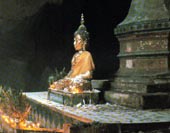By Chalerm Raksanti
In the pale morning light, Buddhist monks walk with grave dignity along busy city streets lined with gleaming skyscrapers. They are clothed in saffron coloured
robes and carry alms bowls. It is Theravada Buddhism which prevails among the majority of the Thai people. There are more than 27,000 wats, or monasteries, scattered
around the country, distinguished by their multi-tiered roofs and elaborate decorations.
 Spirit house on Doi Inthanon, Thailand’s largest mountain
Spirit house on Doi Inthanon, Thailand’s largest mountain
Despite this highly visible evidence of faith, it may be somewhat difficult for foreign visitors to perceive the effects of Buddhism on daily life,
particularly in the sprawling metropolis of the capital city of Bangkok. But once one enters some of the city’s more spectacular wats, the ones which travellers flock to see,
the visitor understands that these temples have little connection with the real world of commerce and traffic which surrounds them. Buddhism views life as but a link in a long
chain, karma, which determines all, and an individual must work for his own salvation.
 15th Century Buddha image kept at Wat Mahathat in Phitsanulok
15th Century Buddha image kept at Wat Mahathat in Phitsanulok
In the countryside, where most of the population lives, the active role played by the monks is far more apparent. Village temples serve as community centres,
where schools and meditation retreats are located beyond the walls. Senior monks serve as guidance counsellors, and advise and arbitrate in local disputes. They also preside at
blessings of new buildings and at weddings, funerals, and at all of the nation’s holy festivals. Massive statues of Lord Buddha are the focal point of these monasteries, and
the pride of the Thai nation.
 Cave temple in northern province of Chiang Rai
Cave temple in northern province of Chiang Rai
Thais also have a healthy respect for the “spirit world”. Thailand is a county known for its tolerant views of life and religion, and a sort of selective
assimilation has become a noble trait of this land. Although 95% of Thais consider themselves Buddhists, it is not the only philosophy that has influence here. Much older beliefs
also show their strong presence.
 Spirit house at Wat Phrathat, Lamphang, Luang
Spirit house at Wat Phrathat, Lamphang, Luang
In every village, town and city, there is a small structure which is the object of considerable attention of the inhabitants. Usually this takes the form of a
small house raised on a post. Sometimes it is a wooden dwelling that resembles a model of a traditional Thai house, or many times a modern cement creation that owes its image and
ornate decoration to the wat. This is the communal spirit house, the home of the invisible guardians of the family property, a commercial building, or perhaps a whole
village. These spirit houses are neatly tended, and daily supplied with food, flowers and burning incense. Properly placated, these spirits of the earth, the air and the water
will watch over communities, homes, and even individual rooms.